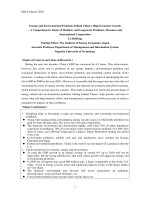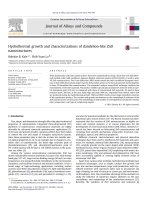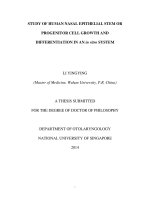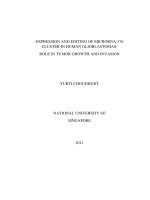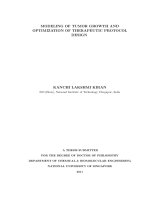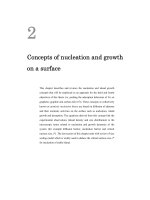Growth and quality respond of potted marigold by applying method of pinching and restarant
Bạn đang xem bản rút gọn của tài liệu. Xem và tải ngay bản đầy đủ của tài liệu tại đây (378.12 KB, 10 trang )
International Conference on Science, Technology, and Environment 2020
Surabaya, December 2-3rd 2020
Growth and Quality Response of Potted Marigold
(Tagetes erecta) by Applying the Method
of Pinching and Retardant
IRMA SANTI*, SITAWATI, NURUL AINI
Department of Agronomy, Faculty of Agriculture,
Universitas Brawijaya
Abstract: Potted plants are generally used as interior decoration, and they require an
ideal posture with lots of flowers to enhance sales. This can be achieved by removing
apical dominance and applying retardant. This study examines the effect of pinching
and paclobutrazol on growth and flowering of marigold pots. This study uses factorial
randomized block design with two factors. Pinching (without pinching, single pinching,
double pinching) was the first factor and paclobutrazol concentration (0, 15, 30, 45
ppm) was the second factor; both were repeated three times. The results show that
pinching and paclobutrazol affected growth and flower quality. The quality of
pinching and paclobutrazol plants decreased plant height and leaf area but increased
plant dry matter and a number of flowers. On the other hand, canopy increased on
pinching and decreased on paclobutrazol. Quality parameters were achieved on
pinching with 45 ppm paclobutrazol indicated as a good fit in producing ornamental
pot plants.
Keywords: Flowering, Paclobutrazol, Quality
1. Introduction
Marigold is an ornamental plant that is widely produced for landscaping, cut
flowers, and decoration purposes. As a potted flower, marigolds are increasingly in
demand because they have flowers with attractive sizes, shapes, and colors. The
problem is that marigold cultivars generally grow tall so that it is difficult to meet the
requirements as a potted ornamental plant. It needs an adoption of technology in easy
and profitable cultivation to produce quality potted marigolds. A possible method to
solve the problem is by applying the method of pinching and paclobutrazol.
The study was conducted to determine whether the type of pinching affects the
concentration of paclobutrazol needed to improve the quality of potted marigold and
whether different types of pinching and concentrations of paclobutrazol affect the
growth and flowering of potted marigold.
*Corresponding author :
Electronic copy available at: />
International Conference on Science, Technology, and Environment 2020
Surabaya, December 2-3rd 2020
The objective of this research was to investigate the effect of different types of
pinching and concentration of paclobutrazol and to get the right type of pinching and
concentration of paclobutrazol in influencing growth and flowering, thereby increasing
the quality of marigold in pots.
2. Theoretical Framework and Hypothesis Development
Ornamental plants have aesthetic values and are widely used to beautify the room,
one of which is marigold. Marigold is from the Asteraceae family and the most popular
commercial flower and widely grown throughout the world. It is able to widely adapt
to various climatic and soil conditions, easy to cultivate, has bright colors ranging from
yellow to orange with the best combination. Attractive and brightly colored flowers are
the most valuable economic part and widely used for making bouquets, religious
offerings, exhibitions, decorations (Bhusari et al, 2017). In general, marigold is tall,
erect-growing up to three feet in height. The flowers are globe-shaped and large with
measure up to 5 inches across with yellow to orange and do not include red colored
marigolds, so this cultivar is suitable for bedding plants (Priyanka et al, 2013).
The characteristics of potted ornamental plants that attract consumers are short
and compact morphology, predictable flowering time, and high aesthetic value (Nordli
et al, 2011). Therefore, the production of potted ornamental plants must be differently
and carefully based on consumer preferences (Megersa et al, 2018). The improvement
of visual quality is the main key and playing an important role to increase purchasing
(Ferrante et al, 2015). Quality depends on the shape, size, color of flowers and leaves,
and number of flowers (Noordergraaf, 1994; Wang et al, 2005). Yellowing of leaves,
loss of flowers and leaves, low flower count and 50% of flowers per plant browning
pot could reduce the quality of potted ornamental plants (Karimi et al, 2012; Ranwala
et al, 2005; Williams et al, 2000). Thus, it takes efforts to increase it through pinching
and paclobutrazol.
Pinching is a technique of cutting or removing terminal shoots to form a sturdy
and tough plant, increasing branching, avoiding dominance of apical shoots and
increasing the number of flowers on the plant. In carnations, there are three types of
258
Electronic copy available at: />
Santi, Sitawati
pinching, namely: single pinching, 1½ pinching, and double pinching. Single pinching
is done only once by removing the apical shoots and leaving 5-6 leaves in the crown.
1½ pinching is like a single pinching, then half of the growing lateral shoots are
pinching back, leaving 2-3 leaves. Double pinching begins with a single pinching,
followed with pinching all the growing lateral shoots leaving 2-3 leaves (Wuryaningsih
et al, 2008). Double pinching on potted Odontonema callistachyum was proven to
produce the shortest plant compared to single pinching and without pinching
(Rezazadeh et al, 2015).
The application of retardant in potted ornamental plants is generally carried out to
control plant height to obtain short and strong plants. Retardants inhibit the synthesis
of gibberellins so that the cell elongation function and the longitudinal growth rate of
plants are inhibited (Krisantini and Tjia, 2011). Plant growth regulators have been
shown to prevent excessive stem elongation and reduce internode lengths in plants
(Kuehny et al, 2001). The retardant widely used to reduce stem elongation in
ornamental plants is paclobutrazol. It is an inhibitor that works physiologically in
inhibiting the biosynthesis of gibberellins in the terpenoid pathway by inhibiting
enzymes that catalyze the metabolic reaction process (Taiz et al, 2005). Its application
by watering through the media is a better way than through the leaves because of the
translocation of paclobutrazol through xylem (Whipker et al, 2003). The hypothesis
was that pinching and paclobutrazol could control growth and improve the quality of
pot marigold.
3. Research Method
This research was carried out in the greenhouse “Angkasa” Abdul Rachman Saleh
airbase, Malang from February until April 2020. It is located at an altitude of ± 500 m
above sea, with the greenhouse’s temperature during the study of 23.5-30.93°C
(minimum-maximum) and average humidity of 64.67%-75%. This study used a
factorial randomized block design with two factors. Pinching is the first factor with 3
levels of treatment including without pinching, single pinching and double pinching.
Paclobutrazol as the second factor consists of 4 levels, namely 0, 15, 30, and 45 ppm.
259
Electronic copy available at: />
International Conference on Science, Technology, and Environment 2020
Surabaya, December 2-3rd 2020
The treatment was repeated 3 times with 15 samples for each treatment; thus, there
were 540 samples of the experimental pot.
Marigold that has been sown for 21 days is transferred to a pot with a diameter of
16 cm. The media used consist of soil, husk charcoal, and cocopeat with a composition
of 1:1:3. The treatment was started with single pinching on day 10, followed with
double pinching after 20 days by pinching all the growing lateral shoots, paclobutrazol
was applicated on day 22. Watering was carried out every day, fertilization of 3 grams
of NPK was given on 7 days afterward, while pest control was done mechanically with
insecticides.
Parameters observed included plant height, canopy width, leaf area, and flower
parameters including flowering time and number of flowers. The resulting data were
analyzed using analysis variance (F) by 5% level, then BNJ by 5% level to see the
difference between treatments.
4. Results and Discussion
The present study investigated the effect of different types of pinching and
concentration of paclobutrazol. This result shows that the interaction between pinching
and paclobutrazol causes a significant difference in plant height. Pinching treatment
affected the concentration of paclobutrazol needed to control plant height (Figure 1).
Figure 1. Effect of pinching on plant height in different concentration of paclobutrazol
(Different latter is significantly different in the 5% BNJ test)
260
Electronic copy available at: />
Santi, Sitawati
The lower plant height was found in the double pinching with 30 and 45 ppm
paclobutrazol. On the other hand, the maximum high plant was found in the without
pinching and paclobutrazol. This result indicates that plant height can be controlled by
pinching and paclobutrazol treatment.
Pinching reduced the need for paclobutrazol to produce shorter crops, this shows
that there is a synergistic effect between pinching and paclobutrazol. Pinching on
apical buds cause inhibition of apical dominance so that axillary shoots to become free
of correlative inhibition of apical dominance and begin to grow, more branching and
the spread of plants, and finally reduced plant height in pinched plants (Rahman et al,
2008). Auxin synthesis in apical shoots to stop when there is inhibition of apical
dominance so that the tips of active branches did not continue to grow, increased
lateral branches, and decreased plant height (Rema and Khader, 1997). Reduced plant
height due to double pinching has been demonstrated in Odontonema callistachyum
(Rezazadeh et al, 2015).
Paclobutrazol works physiologically in inhibiting gibberellin biosynthesis and
inhibiting the oxidation of ent-kaurene to ent-kaurenoic acid which caused a decrease
in the speed of cell division and inhibited plant elongation (Mansuroglu et al, 2009).
Reduction in plant height due to paclobutrazol also been reported of Pelargonium
zonal L. (El Aal et al, 2017) and Lantana camara L. (Muthahara et al, 2018),
Pinching and paclobutrazol treatment statistically affected leaf area and canopy
widht. Table 1.
Table 1. Effect of pinching and paclobutrazol on growth and flowering of Marigold
Treatment
Pinching
P0
P1
P2
BNJ 5%
Paclobutrazol
0 ppm
15 ppm
Leaf area
(cm-2)
Canopy
width (cm)
Dry weight
(g plant -1)
Days to
flower bud
initiation
Number of
flowers plant -1
1143,09 b
1070,56 ab
1016,79 a
86,56
34,03 a
35,35 ab
35,97 b
1,86
17,70 a
18,02 ab
18,99 b
1,09
27,08 a
27,25 a
31,25 b
1,48
5,42 a
7,25 b
7,77 c
0,52
1182,65 b
1088,59 ab
36,67 b
35,21 ab
17,22 a
18,17 ab
29,00
28,00
6,73
6,67
261
Electronic copy available at: />
International Conference on Science, Technology, and Environment 2020
Surabaya, December 2-3rd 2020
30 ppm
1038,03 a
35,07 ab
18,58 b
28,22
6,96
45 ppm
997,98 a
33,51 a
18,99 b
28,89
6,89
BNJ 5%
110,47
2,37
1,39
ns
ns
CV (%)
7,84
5,16
5,82
5,07
7,38
The number followed by the same letter on the same treatment and parameters shows no
significant difference based on the BNJ test by a 5% level. ns = no significant
show that leaf area decreased significantly in the pinching and paclobutrazol treatments.
However pinching treatment increased canopy width, but paclobutrazol decreased it
(Table 1). Without pinching treatment produced maximum leaf area which was
significantly different from double pinching. However, the minimum canopy width
was produced without pinching treatment and significantly different from double
pinching. On the other hand, without paclobutrazol produced maximum leaf area
which was significant than 30 and 45 ppm paclobutrazol. Similarly, maximum canopy
widht was produced without paclobutrazol. Paclobutrazol on 45 ppm decreased canopy
width and was significantly different from without paclobutrazol.
Inhibition of apical dominance causes the plant to stop growing in height, so the
shoots to grow sideways and produce flowers. Pinching not only reduces plant height
but also increase plant width and branching (Beniwal et al, 2003). Plant canopy that is
carried out by pinching is getting wider due to growth on the stems, branches, and
leaves. Pinching affects plant metabolism from vertical to horizontal development and
produces more branches (Salyh, 2013).
The functions of paclobutrazol was to inhibit cytochrome P-450, this enzyme
mediates oxidative dimethylation reactions, including those required for ergosterol
synthesis and conversion of kauren to kaurenoic acid in the gibberellin biosynthetic
pathway (Fletcher et al, 2000). Inhibiting gibberellin caused decreasing in the speed of
cell division and inhibited plant elongation was thought to be related to reduced canopy
width and leaf area. The reduced leaf area has been proven in potted geranium due to
paclobutrazol up to 60 ppm (El Aal and Mohamed, 2017). Retardant application has
also been shown to reduce the diameter of the chrysanthemum crown (Kurnia, 2017).
262
Electronic copy available at: />
Santi, Sitawati
Table 1 reveals that total dry plant weight was increased with pinching. Plants
with double pinching produced maximum plant dry matter per plant and were
significantly different from without pinching. However, single pinching produces total
dry matter per plant was not significantly with without pinching and double pinching.
Besides, paclobutrazol increased dry matter, 45 ppm of paclobutrazol produced
maximum dry matter per plant followed by 30 ppm paclobutrazol, and were
significantly different from without paclobutrazol. The increase in total dry matter of
double pinching by 7.3% higher than that without pinching. While the increase in dry
matter in 45 paclobutrazol treatment by10.28% compared to without paclobutrazol.
The overall effect of the pinching generally practiced promoting bushy growth
canopy with apical fight domination which plays a significant role in the production of
potted plants. It has direct relationship with plant form and subsequent potential for
yield increment too (Martin, 1987). The increase in total plant dry weight indicates the
efficiency of plant biomass formation due to photosynthesis. In the previous study, it
was reported that pinching and paclobutrazol could increase the chlorophyll content of
geranium in pots. Observed there is a relationship between pinching and paclobutrazol
with an increase in cytokinins that stimulates chlorophyll synthesis (El Aal and
Mohamed, 2017). The increase in chlorophyll content has the potential to increase the
photosynthesis process so that more photosynthate is produced.
Table 1. shows that time to flowering increased in the pinching treatment. An
early flower was recorded in control plants followed by single pinching which was
significantly different from double pinching treatment. Double pinching has maximum
time to flower. Similar to the time of flowering, a linear relationship between pinching
treatment with the number of flowers observed. Table 1. shows that minimum flower
was produced in the without pinching treatment and significantly different from all
pinching treatment. Double pinching produces maximum flower and significantly
different from single pinching. Double pinching produces flower by 43,36% than
without pinching and 7,17% than single pinching.
In general, flowering time were delayed by pinching treatments that produced
flower and onset to coloring later than without pinching treatment. This delay in
263
Electronic copy available at: />
International Conference on Science, Technology, and Environment 2020
Surabaya, December 2-3rd 2020
flowering seemed to be a result of pushing the plants back to the juvenile phase after
pinching. The later the pinching occurred, the later the plants flowered. The precise
cause of flowering delay may be attributed to the axillary shoots being in a less
advanced physiological phase than the apical shoot, as they begin to develop only after
pinching. After pinching the plant will return to the juvenile phase so that it actively
forms branches, leaves, and flowers. In addition, the more branches that are produced,
it takes longer to flower because the plants will return to the initial phase and delay the
stimulation of plants to develop (Munir et al, 2006). The delay in flowering time after
pinching occurs in Chrysanthemums (Ona et al, 2015).
However, pinching has been shown to increase the number of flowers. An
increase in the number of flowers increases the value of the pot marigold and thus the
higher quality. In addition, the increase in the total dry weight of the plant causes
energy sources in maintaining plant life, so that the marigold flowers delay in aging
due to pinching and paclobutrazol. Therefore, overall pinching and paclobutrazol
enhancement the quality of potted marigold flowers.
5. Conclusion
In general, the results obtained indicated that all pinching treatments with or
without paclobutrazol concentrations could control plant height. Pinching reduces the
need for paclobutrazol to control plant height. Pinching and paclobutrazol decreased
leaf area but increased total plant dry weight. Pinching increases the width of the
canopy but paclobutrazol decreases it. Although it delays the flowering time, pinching
can produce more flowers. Information on the flowering time of pinching plants can
determine right planting time. Overall, the results show that pinching and 45 ppm
paclobutrazol can be used as the method of choice to produce high-quality plants with
proportional size, compact, produce more flowers and last longer vase life. These
qualities will increase the commercial value of pot marigolds.
264
Electronic copy available at: />
Santi, Sitawati
Reference
Beniwal, B.S., V.P. Ahlawat and S.Rakesh. 2003. Studies on The Effect of Spacing and
Pinching on Growth and Flower Production of Chrysanthemum cv. Flirt. J. Hort. Sci.
32:228–229.
Bhusari, A., Deshmukh,M. and Bhagat. 2017. Effect of Gamma Irradiation on Morphological
Characters of Marigold (Tagetes erecta L.). World J. of Biol. and Biotech. 2(3): 165-167.
El-Aal, A. and Y.F.Y Mohamed. 2017. Effect of pinching and paclobutrazol on growth,
flowering, anatomy and chemical compositions of potted geranium (Pelargonium zonal L.)
Plant. Int. J. of Plant and Soil Sci. 17(6): 1-22
Ferrante, A., A. Trivellini, D. Scuderi, D. Romano and P. Vernieri. 2015. Post production.
Fletcher RA, Gilley A, Sankhla N, DavisTD. 2000.Triazoles as plant growth regulators
and stress protectants. Horticultural Reviews. 24:55–138.
Karimi, M., M.H. Asil, H. Zakizadeh. 2012. Increasing Plant Longevity and Associated
Metabolic Events in Potted Carnation
Krisantini, B.O Tjia. 2011. Panduan Penggunaan dan Aplikasi Zat Pengatur Tumbuh pada
Tanaman Hias. PT. Panca Jaya. Jakarta
Kuehny J.S., A. Peinter and P.C. Branch. 2001. Plug Source and Growth Retardants Affect
Finish Size of Bedding Plants. Hort. Sci. 36(2):321-323
Kurnia, T.I.D. 2017. Morfologis Krisan White dan Yellow Puma dengan Penambahan Retardan.
J. Biologi dan Pembelajaran Biologi. 2(2): 44-53.
Mansuroglu, S., O. Karaguzel, V. Ortacesme and M. S. Sayan. 2009. Effect of Paclobutrazol on
Flowering, Leaf and Flower Colour of Consolida orientalis. Pak. J. Bot., 41(5): 2323-2332.
Martin GC. 1987. Apical dominance. Hort. Sci.22(5):824-833.
Megersa H.G., Lemma and Banjawu. 2018. Effect of plant growth retardant and pot sizes on the
height of potting ornamental plants: a short review. J.of Hort. 5: 1-5.
Munir, M. and F. Naz. 2006. Growth and flowering of snapdragon after release from apikal
dominance. J. of Applied Hort. 8(1): 25-28.
Muthahara, E, Sitawati, S. Agus. 2018. The Effect of Light Intensity and Paclobutrazol on
Flowering of Lantana Plants (Lantana camara L.). RJOS,8(80):447-451.
Noordergraaf, C.V. 1994. Production and Marketing of High Quality Plants. ActaHort.
353:134-148.
265
Electronic copy available at: />
International Conference on Science, Technology, and Environment 2020
Surabaya, December 2-3rd 2020
Nordli, E.F., M. Storm and S. Torre. 2011. Temperature and Photoperiod Control of
Morphology and Flowering Time in Two Greenhouse Grown Hydrangea macrophylla
Cultivars. J. Sci.Hort.127: 372-377.
Ona, A.F., T. Taufique, M.Z.K. Roni, N.J. Jui, A.F.M.J. Uddin. 2015. The Influence of
Pinching on Growth and Yield of Snowball Chrysanthemum. IJBSSR. 3(3):174-178.
Priyanka, D., T. Shalmi and V. K. Navneet. 2013. A Brief Study on Marigold (Tagetes Species):
A Review. Int. Res. J. of Pharm. 4(1):43-48
Rahman, H.2008. Characterization of chrysanthemum germplasm. An M. S. thesis, Dept. of
Horticulture, Sher-e- Bangla Agricultural University, Sher-e-Bangla Nagar, Dhaka,
Bangladesh.82p.
Ranwala, A.P., W.B. Miller. 2005. Effects of Cold Storage on Postharvest Leaf and Flower
Quality of Potted Oriental-Asiatic and LA-Hybrid Lily Cultivars. Sci. Hort.105: 383–392.
Rema, M. & Khader, M.A. 1997 Effect of Leaf Plucking on The Growth and Grain Yield of
Coriander Indian Cocoa Arecanut Spices J. 21:74 -75.
Rezazadeh, A and R. L. Harkess. 2015. Effect of Pinching of Cuttings per Pot and Plant Growth
Regulator on Height Control of Purple Firespike. Hort. Tech. 25 (1): 71-75.
Salyh T. M. 2013. Effect of Nitrogen Fertilization, Planting Media and Pinching on the Growth
and Volatile Oil of Geranium Plants (Pelargonium graveolens L’ Herit). Thesis.
University of Duhok, Duhok, Iraq. 82 pp.
Taiz, L. and E. Zeiger. 2002. Plant Physiology. Sinauer Associates, Inc. Publishers. Sunderland.
559 pp.
Wang, Q., J. Chen, R.H. Stamps and Y. Li. 2005. Correlation of Visual Quality Grading and
SPAD Reading of Green-Leaved Foliage Plants. J. Plant Nutr. 28: 1215–1225.
Whipker BE, M.C Call. 2000. Response of Potted Sunflower Cultivars to Dominozide Foliar
Spray and Paclobutrazol Drenches. Hort.Tech. 10:209-211.
Williams, M.H., E. Rosenqvist, M.Buchhave. 2000. The Effect of Reducing Production Water
Availability on the Post-Production Quality of Potted Miniature Roses (Rosa×hybrida).
Postharvest Biol. Tech.18:143-150.
Wuryaniningsih,S., K. Budiarto, Suhadi. 2008. Pengaruh Cara Tanam dan Metode Pinching
terhadap Pertumbuhan dan Produksi Bunga Potong Anyelir. J. Hort.18(2): 135-140.
266
Electronic copy available at: />

